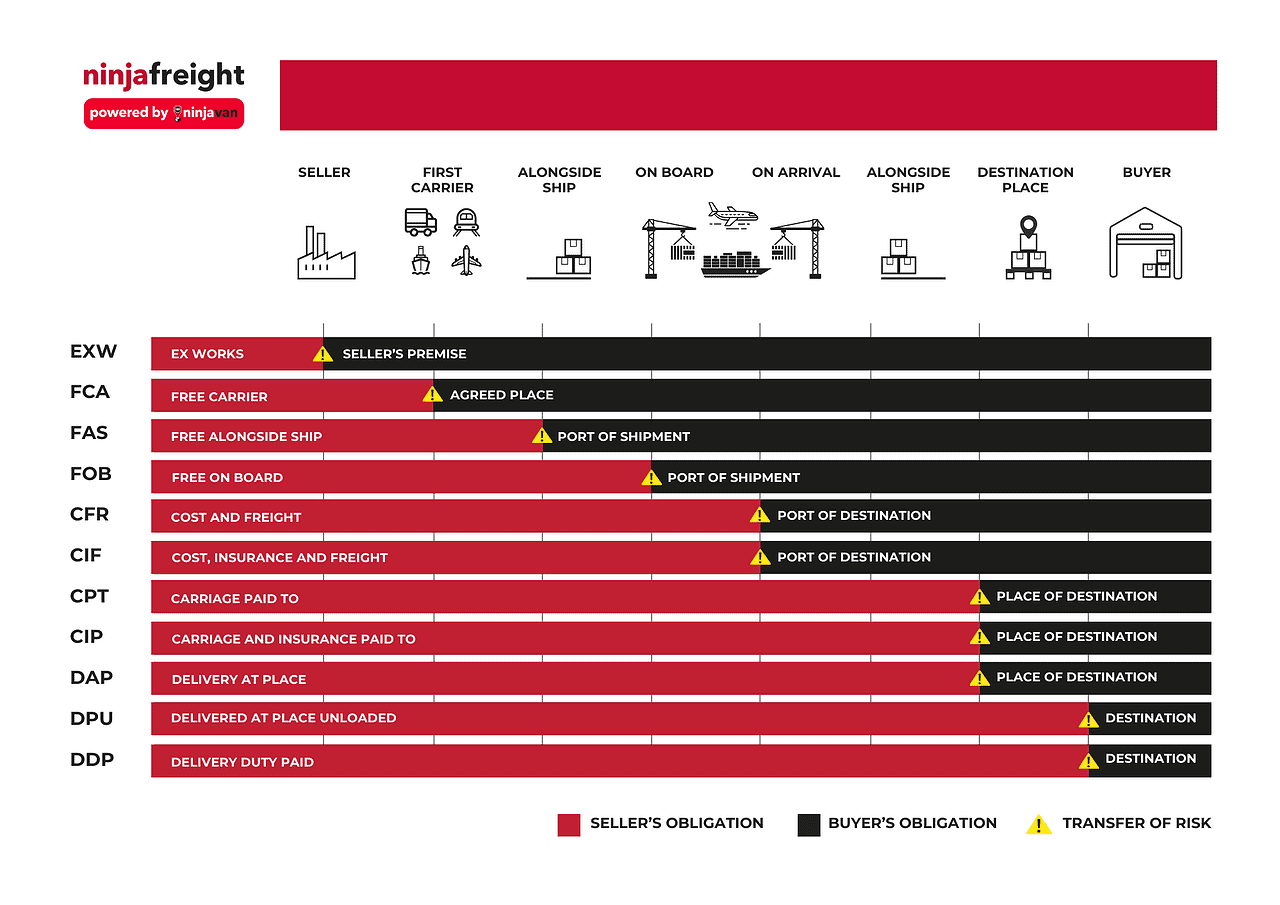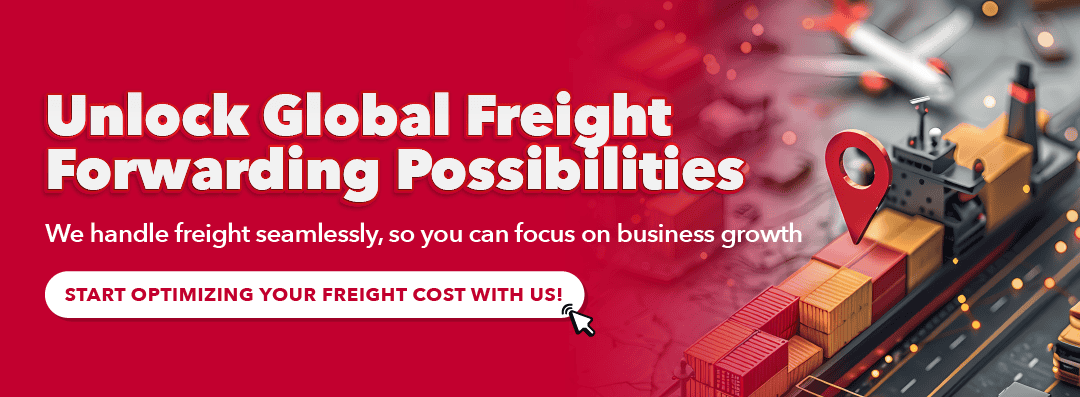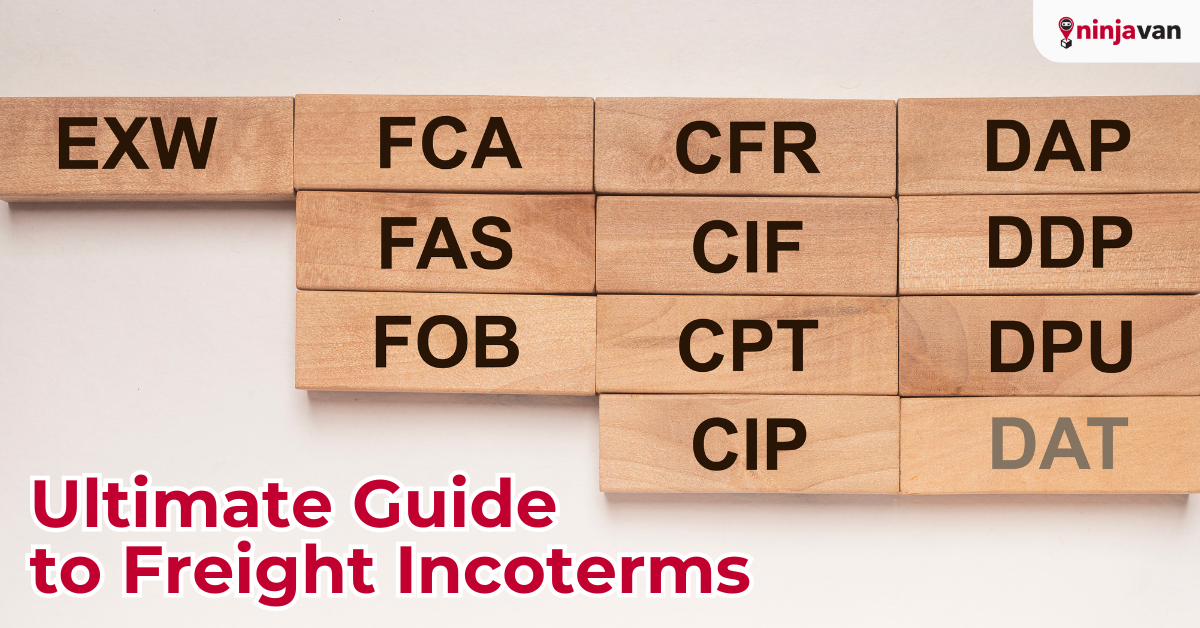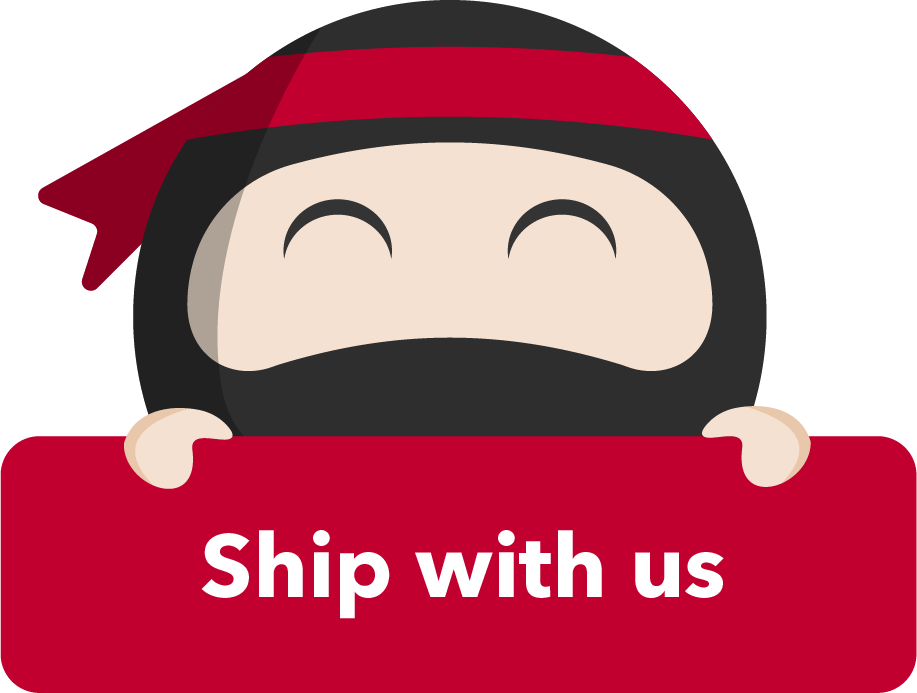What Are Incoterms?
Incoterms, or International Commercial Terms are standardized terms published by the International Chamber of Commerce (ICC) that clearly communicate the tasks, costs, and risks associated with transporting and delivering goods. They help avoid misunderstandings by clarifying who is responsible for shipping, insurance, and tariffs during importing & exporting. Introduced in 1936, Incoterms have been periodically updated, with the latest version being Incoterms 2020.
Incoterms Grouping based on Mode of Transport
All Types of Transport Modes (7 Incoterms)
1. EXW (Ex Works)
2. FCA (Free Carrier)
3. CPT (Carriage Paid To)
4. CIP (Carriage and Insurance Paid To)
5. DPU (Delivered at Place Unloaded)
6. DAP (Delivered at Place)
7. DDP (Delivered Duty Paid)
Sea and Inland Waterway Transports (4 Incoterms)
1. FAS (Free Alongside Ship)
2. FOB (Free On Board)
3. CFR (Cost and Freight)
4. CIF (Cost, Insurance, and Freight)

The chart above gives you a clear and detailed look at Incoterms 2020, showing who does what at each step of the shipping journey—from the seller’s place to the final destination. You can easily see when the seller’s job ends and the buyer’s begins.
Using this chart, we’ll compare a few Incoterms with similar risk transfer points to help you better understand their key differences.
EXW vs FCA Incoterms
| Incoterms | Seller’s Responsibilities | Buyer’s Responsibilities |
| EXW (Ex Works) | Make the goods available at their premises (factory, warehouse, etc.) Not responsible for loading the goods onto the collecting vehicle or for export customs clearance | Buyer bears all costs and risks involved in taking the goods from the seller’s premises to the final destination Responsible for loading, transportation, export customs clearance, and all other formalities and costs |
| FCA (Free Carrier) | Delivers the goods to buyer’s specified place Seller is responsible for export customs clearance and bears the cost of delivering the goods to the named place | Buyer assumes all risks and costs once the goods have been delivered to specified place Buyer is responsible for the main carriage, import customs clearance, and further transportation to the final destination |
| Key Differences | Loading and Transport: In EXW, the buyer arranges for the loading and transportation from the seller’s premises. In FCA, the seller handles the loading and delivery to the specified location or carrier Export Customs Clearance: In EXW, the buyer is responsible for export customs clearance, whereas in FCA, the seller takes care of it Risk and Cost Allocation: EXW places more responsibility on the buyer, making it suitable when the buyer has better logistics capabilities and local knowledge. FCA offers a more balanced allocation of responsibilities, with the seller handling initial logistics and export formalities | |
FAS vs FOB Incoterms
(Sea & Inland Transport)
| Incoterms | Seller’s Responsibilities | Buyer’s Responsibilities |
| FAS (Free Alongside Ship) | Responsible for delivering the goods alongside the vessel on the quay or in the dock at the named port of shipment Handles export customs clearance | Bears all costs and risks from the moment the goods are placed alongside the ship Responsible for loading the goods onto the vessel, main carriage, insurance, and import customs clearance |
| FOB (Free On Board) | Delivering the goods on board the vessel at the named port of shipment Handles export customs clearance and all costs until the goods are loaded onto the ship | Assumes all risks and costs from the moment the goods are on board the vessel Responsible for loading the goods onto the vessel, main carriage, insurance, and import customs clearance |
| Key Differences | Point of Delivery: In FAS, the delivery is completed once the goods are placed alongside the ship. In FOB, the delivery is completed once the goods are loaded on board the ship Loading Costs: In FAS, the buyer is responsible for the costs of loading the goods onto the vessel. In FOB, the seller bears these costs | |
CFR vs CIF Incoterms
| Incoterms | Seller’s Responsibilities | Buyer’s Responsibilities |
| CFR (Cost & Freight) | Cost of transportation of the goods to the named port of destination Handles export customs clearance and bears the costs until goods are loaded on board the vessel at port of shipment | Assumes the risk of loss or damage to the goods once they are on board the vessel at the port of shipment Responsible for insurance, import customs clearance, and any further transportation costs from the port of destination |
| CIF (Cost, Insurance & Freight) | Same as CFR and in addition, must also procure insurance against the buyer’s risk of loss or damage to the goods during the carriage | Same as CFR except that seller has to provide insurance coverage |
| Key Differences | Insurance: Under CFR, the seller has no obligation to provide insurance; the buyer must arrange for insurance coverage Under CIF, the seller must provide insurance coverage for the goods during the carriage to the port of destination, offering an additional layer of security for the buyer | |
CPT vs CIP vs DAP Incoterms
| Incoterms | Seller’s Responsibilities | Buyer’s Responsibilities |
| CPT (Carriage Paid To) | Cost of transportation of the goods to the named port of destination Handles export customs clearance and bears the costs until goods are handed over to first carrier | Assumes the risk of loss or damage to the goods once they are handed over to first carrier Responsible for insurance, import customs clearance, and any further transportation costs from the place of destination |
| CIP (Carriage and Insurance Paid To) | Same as CPT and in addition, must also procure insurance against the buyer’s risk of loss or damage to the goods during the carriage | Same as CPT except that seller has to provide insurance coverage |
| DAP (Delivered at Place) | Arrange and pays for all transportation costs to deliver the goods to the named place of destination | Responsible for unloading the goods and for import customs clearance and any associated costs |
| Key Differences | Point of Risk Transfer: For CPT and CIP, the risk transfers to the buyer once the goods are handed over to the first carrier. For DAP, the risk transfers to the buyer when the goods are made available for unloading at the named place of destination Insurance: CPT & DAP does not require the seller to provide insurance. The buyer must arrange for their own insurance if desired. CIP requires the seller to provide insurance coverage for the goods during transit Responsibilities at Destination: In CPT and CIP, the buyer is responsible for import customs clearance and any further transportation from the destination. In DAP, the seller is responsible for transportation to the named place, but the buyer handles unloading and import customs clearance | |
DPU vs DDP Incoterms
| Incoterms | Seller’s Responsibilities | Buyer’s Responsibilities |
| DPU (Delivered at Place Unloaded) | Handles all costs and risks associated with transportation to the designated location, including unloading Export customs clearance | Responsible for import customs clearance, duties, taxes, and any further transportation from the place of delivery |
| DDP (Delivered Duty Paid) | Handles all aspects of transportation, insurance, customs clearance and export/import duties & taxes up till designated location | Only responsible for unloading the goods at the final destination |
| Key Differences | Customs and Duties: Under DPU, the buyer is responsible for import customs clearance, duties, and taxes. Under DDP, the seller handles these responsibilities Cost Allocation: DPU requires the seller to cover costs up to and including unloading at the specified place, with the buyer covering import-related costs. DDP places almost all costs on the seller until the goods reach the final destination | |
Conclusion
Selecting the best Incoterm for your business involves understanding your specific needs and the nature of your international trade transactions.
- Start by assessing your shipping and logistical capabilities, including whether you have the means to handle customs clearance and delivery at the destination
- Consider the level of control and responsibility you want over the shipping process, as some Incoterms place more responsibility on the seller while others on the buyer
- Evaluate the risks and costs associated with each Incoterm, including insurance and potential delays
Consulting with logistics and freight forwarding experts can also give you personalized insights to help you make the best choice for your business!








